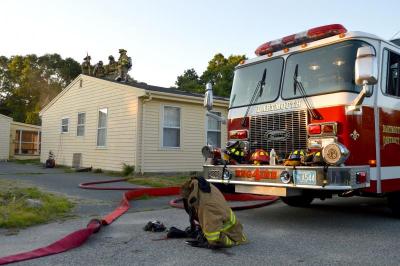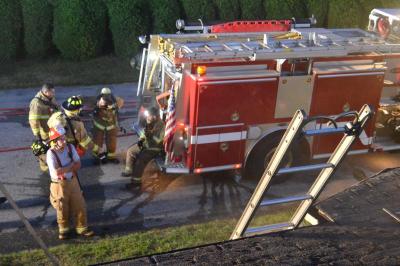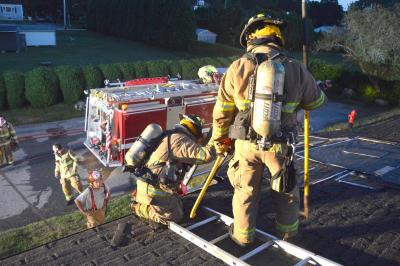Dartmouth’s firefighters learn to keep a cool head in intense heat
Where there’s smoke, there’s fire. But this week on Emerson Street, there was only smoke and a couple dozen firefighters testing their skills.
The three-bedroom, ranch-style house on 49 Emerson St. became the site of a mock house fire drill. The house, which is scheduled for demolition in the next couple of weeks, was donated to Fire District 1 for training purposes. Three fire trucks parked along the dead end street as a small crowd looked on in awe.
“We were given the house by realtor Dave Vermette, which we greatly appreciate because it allows our guys to do hands-on training with a structure,” said Acting Fire Chief Jake Bettencourt of Fire District 1. “We simulated a direct-fire attack with a reported victim in the dwelling.”
The house was transformed into something resembling a movie set. A smoke machine filled the building from ceiling to floor with thick fog and a plastic dummy stood in as the hapless victim.
Teams of two worked together to find the plasticine resident inside the building. This required 60 pounds of gear, including the bulky boots, jackets and overalls one might expect a firefighter to wear as well as a self-contained breathing apparatus.
The apparatus supplies the wearer with about 20 minutes of breathable air and is fastened on like a backpack. A hose latches onto a tight-fitting gas mask, creating a seal.
Rather than bursting into the building full bore, firefighters would go in two at a time, crawling on their hands and knees in search of the victim. To ensure the two aren’t separated, the person in back grabs onto the leg of the person in front. With a left-hand sweep of the building, the duo snakes its way around the perimeter of the building, inspecting the left-most rooms first.
Visibility inside the building was so low that a thermal imaging camera would be needed to find anyone trapped inside.
“You check every room behind every door before, hopefully, you find the victim,” said Justin Pacheco, who’s been with Fire District 1 for three years. “It’s intense because all your senses are heightened. You can’t see. It’s hot. Different elements make it challenging.”
Bettencourt said that, had there been an actual fire, the first truck to arrive on scene would be an “attack pumper.” The crew driving that truck would already be geared up.
“They make the initial attack, so their job is to go in, attack and search for the victim. We then add a back-up team — what they call a RIT team, a Rapid Intervention Team,” he said.
At the same time, to release the heat and smoke trapped inside the house, a group would make their way onto the roof and, using power tools and axes, cut a three-by-three square to vent the building.
This adds another challenge for the group sweeping the house below.
“It’s always loud in there,” said Bettencourt. “You would have these guys sawing. You would have smoke cracking. You would have radios talking.”
“Your mind starts going crazy, and you have to stop and think,” said Firefighter Skott Rebelo. “You have to regroup before you get in there because you have to have a cool head on your shoulders.”
At the end of the training session, firefighters were given the chance to fire the hose into an empty bedroom. Again, because visibility is so low, sound is crucial. The only way to detect if water is successfully passing through the door way is to listen for the impact against the walls.
While the drill didn’t involve an actual fire, the summer heat and the weight of the gear ensured that anyone participating in the trial was dripping with sweat after leaving the building. The drill was physically demanding, and Bettencourt said that’s why it’s important for firefighters to train.
“We do an endurance test once a year. There’s no pass or fail, we want guys to test themselves and measure themselves,” he said.
Participants are timed to see how quickly they can equip all their gear. They also have to climb ladders, swing an axe 20 times, carry a 40-pound bag around the station three times and complete an obstacle course.
“We do it for 20 minutes. The idea is to get the men comfortable with controlling their breathing,” said Bettencourt.
And all of that training helps the firefighters of Dartmouth prepare for real house fires — as well as the fake ones.
Pacheco noted that there’s more to being a firefighter than gearing up in an awesome outfit and charging into a burning house like a superhero.
“You can’t want to do it because you think it’s a cool thing to do,” said Pacheco. “You gotta be dedicated. You can’t get complacent. You always have to learn.”




















